Many admirers of Austen will be familiar with the works of Anthony Trollope (1815–1882), separated from Austen by only one generation. Trollope’s novels, especially the Chronicles of Barsetshire, can be seen to pick up chronologically from where Austen leaves off as he charts the ordinary everyday lives in English villages in the period directly after Austen’s, with a particular focus on the clergy. Relatively little has been written, however, examining the relationship between the two. The following article does not aim to present a critical comparison of their work, methods, and style but rather focuses on the biographical connections between the two authors and Trollope’s own views on his predecessor, as indicated in his work, correspondence, and annotations.
An unlikely starting point can be made in a newly found obituary of Austen. David Gilson’s A Bibliography of Jane Austen identifies eleven obituaries that appeared in various newspapers in the months immediately after her death (Gilson 470–71). To this number can now be added three more (see Appendix A for full details). Of particular interest is that of the Oxford University and City Herald from Saturday 2 August 1817, as it mentions a significant death almost directly after that of Austen: “Mrs Meetkirke [sic], wife of A. Meetkirke, esq. of Julians, Hertfordshire.” This was Barbara Meetkerke, who died on 25 July 1817, her husband being Adolphus Meetkerke (1753–1841), Anthony Trollope’s great uncle1 Trollope’s older brother, Tom, would recall his great aunt in volume one of his autobiography, What I Remember: “She was an admirable specimen of a squiress, as people and things were in that day. I suppose that there was not a poor man or woman in the parish with whose affairs of all sorts she was not intimately acquainted” (1: 64)—a description that makes her sound a little like Lady Catherine de Bourgh. He also recalls in the same passage that his great uncle had a maiden sister, Mrs. Anne, who kept house. He described her as “a prim-looking, rosy-apple-faced, most good-natured little woman. She always carried a little basket in her hand, in which were the keys, and a never-changed volume of Miss Austen’s Pride and Prejudice, which she always recommenced as soon as she had worked her way to the end of it.”2
The Meetkerkes were childless, and Trollope’s father, Thomas Anthony (1774–1835), was acknowledged as his uncle’s heir, with his eldest son, Anthony’s older brother Tom, even being introduced to the tenantry as such (Hall 12). But in October 1818, just over a year after his wife’s death, Adolphus Meetkerke, then in his mid-sixties, suddenly and unexpectedly married a young woman, Matilda Jane Wilkinson.3 He quickly produced an heir, another Adolphus Meetkerke, who would live until 1879 and whose arrival meant that Trollope’s father would no longer inherit his great expectations, a fact that would shape the course of Trollope’s life (Glendinning 12, xiv).
Trollope was born at No. 16 Keppel Street, Russell Square on 24 April 1815. His father had lived here as a bachelor,4 and when Henry Milton, a clerk in the War Office, moved into No. 27, his older sisters, Frances and Mary, came to keep house for him in 1803. In the summer of 1808, Henry introduced his sisters to Thomas Trollope, which resulted in his proposing to Frances that year. They were married on 23 May 1809, and Trollope’s older brother Tom was born in Keppel Street on 29 April 1810 (Hall 3–9). In his An Autobiography, Anthony Trollope stated that he was taken to Harrow “while a baby,” as his father had leased land there to farm, a disastrous decision as it turned out (9). It is unclear when the Trollopes left Keppel Street; it could have been within a year or so of Anthony’s birth, with 1817 sometimes being cited.5 It is also possible that the family returned periodically to Keppel Street and so spent some time in London; there is evidence that the family used the house well into the 1820s. Trollope also mentions Keppel Street repeatedly in at least three of his works, which cannot be a coincidence (Mullen 12–13).6
The address is significant because the Palmer family, who would later become Charles Austen’s in-laws, left Bermuda for England in 1802 and secured the tenancy of No. 22 Keppel Street, across the street and a few doors down from the Trollopes (Kindred 13). Fanny Palmer’s biographer has noted that “22 Keppel Street would become an important place for her,” and we know that she visited her family here, along with her two daughters, in the autumn of 1811 (Kindred 87, 77). The whole family, including Charles Austen, spent the Christmas of 1811 there (87) and did so again in 1813 (Le Faye, Chronology 475). Mrs. Trollope may well have known Fanny, even if just by sight, as they were both young mothers on the same street (Kindred 78).7 If she didn’t subsequently hear of Jane Austen’s work through her neighbors, she certainly heard of it via her correspondents. Mrs. Trollope had met Mary Russell Mitford (1787–1855) in Hampshire before her marriage, and in 1832 Mitford wrote to her: “I have not a doubt that [the writing of novels] is by far the most profitable branch of the literary profession. If ever I be bold enough to try that arduous path, I shall endeavour to come as near as I can to Miss Austen, my idol” (T. Trollope 2 :340–41).
Fanny Palmer was to die on 6 September 1814, shortly after giving birth to her fourth child and just under eight months before Trollope was born (Le Faye, Chronology 488). As a result, Charles’s three daughters were sent to live in Keppel Street with his in-laws and his spinster sister-in-law, Harriet Palmer (c. 1786–1867).8 In a letter dated 30 November 1814 from her brother Henry’s house in Hans Place, Austen mentions visiting Keppel Street to see her nieces and brother; she returned again in 1815, the year of Trollope’s birth, on 25 November (26 November 1815). Since we are unsure as to when the Trollope family left Keppel Street and whether they returned, it is possible that the young Trollope would have been near neighbors with Austen’s nieces and maybe even have passed by Austen herself. Charles Austen was also living at Keppel Street by late June 1816 (Kindred 180) and spent much of the first half of 1817 there (Le Faye, Chronology 551 ff.). When he saw Jane Austen for the last time in June 1817, he arrived from, and returned to, Keppel Street (Le Faye, Family Record 251–52).
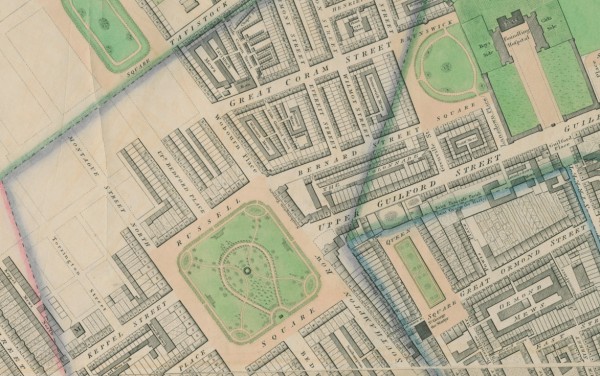
Keppel Street (bottom left) and the surrounding area, from Richard Horwood’s map of London as reproduced by William Faden in 1819. To the northeast is Russell Square; beyond is Brunswick Square, home of John and Isabella Knightley. The area to the north of Keppel Street is now occupied by University College London. Reproduced with the kind permission of Dr. Matthew Sangster (www.romanticlondon.org).
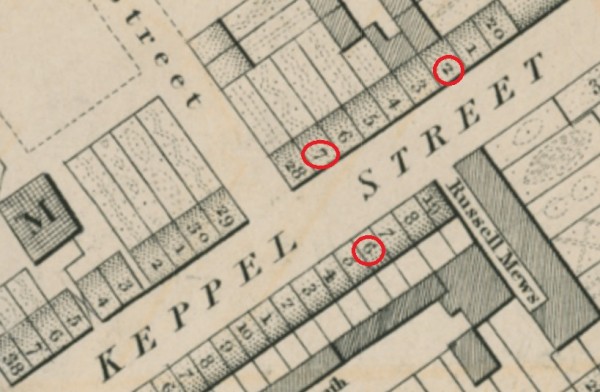
Detail of Keppel Street (note that the tens in the house numbers are not repeated). The Palmers lived at No. 22, the Trollopes at No. 16; prior to her marriage Frances lived with her brother at No. 27. Reproduced with the kind permission of Dr. Matthew Sangster (www.romanticlondon.org).

University of London’s Senate House now occupies most of Keppel Street, but a small plaque, shown here, commemorates the approximate site of Trollope’s birth. Reproduced with the kind permission of Jo Strong and Mick Bright.
Although Trollope attended Harrow school from the early spring of 1823 to early 1825, he was eventually sent to Winchester in April 1827, leaving there after mid-July 1830 (Super 5–12). One of his contemporaries there was Austen’s nephew George (1812–1903), son of her brother Frank (Austen, Letters 492n4). There, in the cathedral where he worshipped, Trollope would have seen the simple memorial to Jane Austen, who had been buried there in the previous decade. By his own account he worshipped there or in the chapel as often as three times a day (Super 8). We know that Trollope read Austen as a young man, as he would later state in his autobiography, which appeared in 1883, the year after his death. At nineteen, he wrote, “I had already made up my mind that Pride and Prejudice was the best novel in the English language,” although he immediately qualified the praise: “—a palm which I only partially withdrew after a second reading of Ivanhoe, and did not completely bestow elsewhere till Esmond was written” (Trollope, Autobiography 32).
Publishers also link the two authors. Richard Bentley (1794–1871), who published the first collected edition of Austen’s works, had published a number of Frances Trollope’s novels and would go on to publish Trollope’s The Three Clerks (1857); Trollope would serialize his novel The American Senator in Temple Bar under the editorship of Bentley’s son, George (Mullen and Munson 39–40). When Trollope himself was editor of St. Paul’s Magazine, he wrote to Richard Bentley in November 1869 to request a review copy of J. E. Austen-Leigh’s Memoir of Jane Austen. Trollope opens his letter: “My dear Mr. Bentley, You are bringing out a life of my chief favourite among novelists, Jane Austen.” The review copy was for Juliet Pollock, whose review appears in the March 1870 edition of St. Paul’s (Letters 1: 486–87). We also know from catalogues of Trollope’s library made in 1867 and 1874 that he owned the five-volume edition of Austen’s work published by Bentley in 1832–33 in its 1856 reissue, although he probably also read the works in other editions (Trollope, An Autobiography 323). Trollope’s copies are now in the Robert H. Taylor Collection at Princeton. In his copy of Emma there are notes in the back endpapers in his hand dated August 17, 1864, which contain a number of criticisms, as well as some praise. (See Appendix B for the full text.) They open with the refreshingly frank “Emma is undoubtedly very tedious” before criticizing the men as “all weak” and concludes by noticing
Miss Austens timidity in dealing with the most touching scenes which come in her way, and in avoiding the narration of those details which a bolder artist would most eagerly have seized. In the final scene between Emma and her lover,—when the conversation has become almost pathetic,—she breaks away from the spoken dialogue, and simply tells us of her hero’s success. This is a cowardice which robs the reader of much of the charm which he has promised himself.
A yet more important and less frequently examined work is Trollope’s lecture “On English Prose Fiction as a Rational Amusement,” delivered in January 1870 and repeated on a number of occasions afterwards. First published in 1938 in Four Lectures, Trollope here provides a selected survey of the English novel. After discussing the gothic novel, he pairs Austen and Maria Edgeworth, defining three key characteristics in his description of them as “two ladies who wrote novels which were true to life, full of excellent teaching, and free from an idea or a word that can pollute” before continuing, “I shall not enter here upon a criticism of Miss Edgeworth’s works, which in my judgement lack a certain strength which those of Miss Austen possess” (104–05). In a section dedicated to Austen he adds,
Miss Austen was surely a great novelist. I do not know how far I may presume that you are acquainted with her works, but I recommend such of you as may not be so, to lose no time in mending that fault. What she did, she did perfectly. Her work, as far as it goes, is faultless. (105)
Although there are significant differences, Trollope’s keenness to defend the novel in this lecture, as is apparent in its very title, overlaps with Austen’s own defense, expressed so forcefully in Northanger Abbey: “only some work in which the greatest powers of the mind are displayed, in which the most thorough knowledge of human nature, the happiest delineation of its varieties, the liveliest effusions of wit and humour are conveyed to the world in the best chosen language” (31).
Another relatively unknown work of Trollope also deserves examination in the context of Austen. The New Zealander was written c. 1855–1856, after The Warden but before Barchester Towers (The New Zealander xv). Trollope does not mention it in his autobiography, and it was not even published until 1972. Ironically, given certain passages in The Warden, it bears a certain affinity with Carlyle, with its opening paragraph asking, “Have the glories of Great Britain reached their climax, culminated, and begun to pale?” (3). An odd book, it perhaps tells us more about Trollope himself at this stage of his life than anything else. It contains thirteen chapters on topics such as the press, the law, the army and navy, society, art, and literature, the last of which is of particular interest. Trollope mentions eighteen giants of English literature, although, surprisingly, almost all of them were primarily known as poets. As Trollope’s editor points out, however: “One suspects that had his list been revised some fifteen years later, say at the time of his lecture ‘On English Prose Fiction as a Rational Amusement,’ it would have included Jane Austen, Thackeray, and Scott as a novelist” (The New Zealander xviii).9 Austen is mentioned, however, in the chapter on society. After a passage highly critical of Fielding, Richardson, and Burney, Trollope comments:
Since the writing of Pepys’ Diary Miss Austen has perhaps gone the nearest towards giving us a true insight into the houses of the people of her day. With Mr. and Mrs. Bennet and Lady Catherine de Bourgh we are quite at home. With the Bertrams and the Crawfords we have our sympathies and antipathies as we have with the surrounding families in our own village or our own circle. The return of Sir Thomas is as when our own father came upon us in our juvenile delinquencies; and we can hardly help believing that we ourselves received Mr. Collins’ letters each with one of Rowland Hill’s penny stamps in the corner of the envelope. (The New Zealander 158).10
What is so striking about this paragraph is that it states exactly what could be and would be written of Trollope himself and his characters.
The above quotations show that Trollope’s appreciation of Austen was lifelong, from his teenage reading, through to middle age, down to his autobiography, which dates to his last years.11 The overlap in the themes and content of their novels makes it odd that the critical literature directly comparing the two is relatively sparse.12 After reading Austen, Edith Wharton wrote to a friend in 1930 that she was flirting with the idea of writing an article on Austen and Trollope: “They deserve to be coupled” (qtd. in Tyler 93).
This coupling had occurred to some before, but they were few, such as the unknown reviewer of The Kellys and the O’Kellys in the Athenaeum of 15 July 1848, who wrote, “Then, though they are less national, Lord and Lady Cashel are a pair whom Miss Austen need not have disowned” (Smalley 553). Similarly, the Saturday Review’s notice of The Small House at Allington in 1864, stated, “He can do, in fact, what Miss Austen did, only that he does it in the modern style”13 (Smalley 205). A particularly perceptive comparison was made by Richard Holt Hutton (1826–1897), co-editor of The Spectator, who had also written on Austen (Smalley 509–511). In an essay titled “From Miss Austen to Mr. Trollope,” which appeared on Austen’s birthday in 1882, shortly after Trollope’s death, he contrasted the haste that characterized Trollope’s novels with the more easy going pace of Austen’s. Trollope’s characters are constantly on the move, making appointments, catching trains, going up to London. The anxieties and stresses that face a number of his characters form a sharp contrast to the more leisurely procession we find in Austen’s more insular, indeed parochial, universe. A comparison between the two brings into sharp relief the changes that had occurred in the last fifty years, something that Austen-Leigh’s Memoir, published exactly thirteen years earlier, had also picked up on.
A final point to note is that the comparison between the two novelists has not always been flattering. A leader article in The Times, published on 7 December 1882, the day after Trollope’s death, defines his world as “the heir of Miss Austen’s” before stating that posterity will not place Trollope in the first class of novelists of the century, adding, “Neither, we believe, will it admit Miss Austen, great as she is” (Smalley 502). John Sutherland notes that a “commemorative stone to Trollope’s memory was laid in Poets’ Corner in Westminster Abbey in 1993. A hundred years too late, some would say” (645). Austen had to wait 150 years after her death, with her memorial there appearing only in 1967 and, even then, only because a member of the Jane Austen Society, Phyllis Mary Keith Sweeting, had suggested it (Looser 132).14
The achievements of both novelists were perhaps not fully appreciated by their contemporaries and those who came immediately after them, but this is not a mistake that their successors have made.
Appendix A: Newly found obituaries of Jane Austen
Cambridge Chronicle and Journal, No. 2857 (Friday, 25 July 1817)
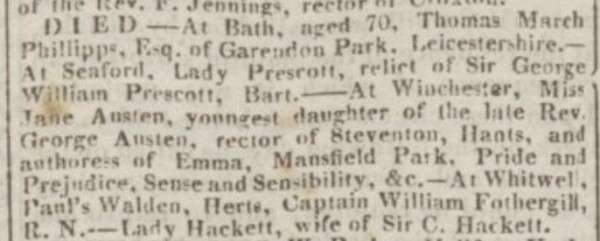
© The British Library Board. All rights reserved. With thanks to The British Newspaper Archive http://www.britishnewspaperarchive.co.uk/.
“At Winchester, Miss Jane Austen, youngest daughter of the late Rev. George Austen, rector of Steventon, Hants, and authoress of Emma, Mansfield Park, Pride and Prejudice, Sense and Sensibility, &c.”
The Public Ledger and Daily Advertiser, Vol. 57, No. 17,884 (Wednesday, 30 July 1817)

© The British Library Board. All rights reserved. With thanks to The British Newspaper Archive http://www.britishnewspaperarchive.co.uk/.
“July 18, at Winchester, Miss Jane Austen, youngest daughter of the Rev. George Austen, Rector of Steventon, Hants.”
The Oxford University and City Herald and Midland County Chronicle, Vol. 12, No. 584 (Saturday, 2 August 1817)

© The British Library Board. All rights reserved. With thanks to The British Newspaper Archive http://www.britishnewspaperarchive.co.uk/.
“At Winchester, Jane, youngest daughter of the Rev. G. Austen, rector of Steventon, Hants. She was the ingenious Authoress of Emma; Mansfield-Park; Pride and Prejudice; and Sense and Sensibility.” Notice of Mrs Meetkerke’s death follows shortly after, as indicated.
Appendix B: Anthony Trollope’s note on Emma: A new transcription
Anthony Trollope’s admiration for Jane Austen is well attested. Among the proofs are Trollope’s own set of Austen’s novels, which have survived and are at Princeton University Library.15 Trollope wrote a lengthy note on the endpapers of his copy of Emma, which was published in 1949 by Bradford Booth. Another transcription appeared in Nicholas Shrimpton’s 2014 Oxford World’s Classics edition of Trollope’s An Autobiography and Other Writings (231–32). There are errors and omissions in both versions, the most significant being the fourth leaf, which has been completely omitted in both cases. Princeton University Library has kindly granted permission for digital photographs of Trollope’s note to appear below. The photographs are preceded by a transcription that identifies departures from Booth and Shrimpton. The library was also able to confirm that this annotation is the sole one in the set, the other volumes being clean.
Leaf 1
|
Emma is undoubtedly very tedious;—thereby But the story shews wonderful knowledge The humour shewn in some of the |
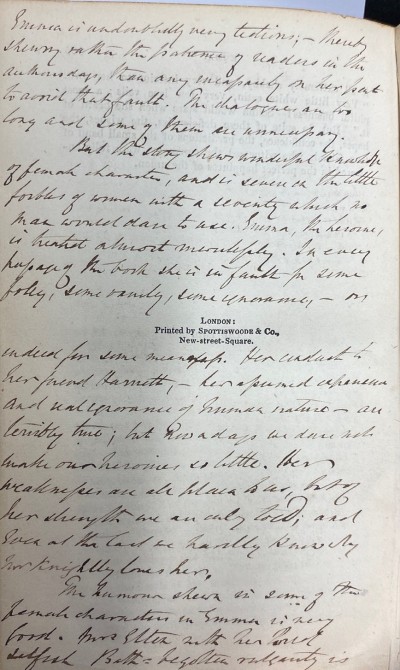 Leaf 1. © Princeton University Library. All rights reserved. |
Leaf 2
|
excellent; and Miss Bates, longwinded, We have here, given to us unconsciously, |
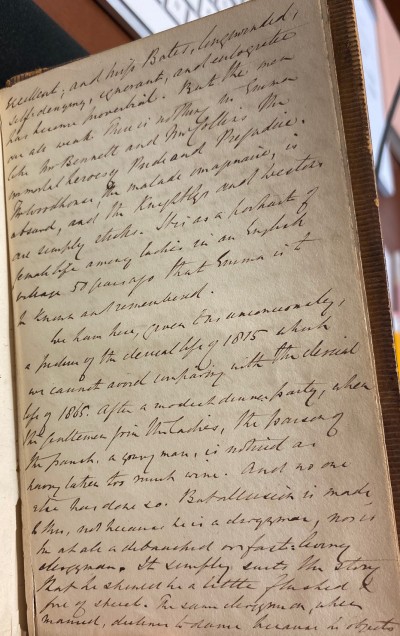 Leaf 2. © Princeton University Library. All rights reserved. |
Leaf 3
|
to the partner proposed to him; and special I cannot but notice Miss Austens |
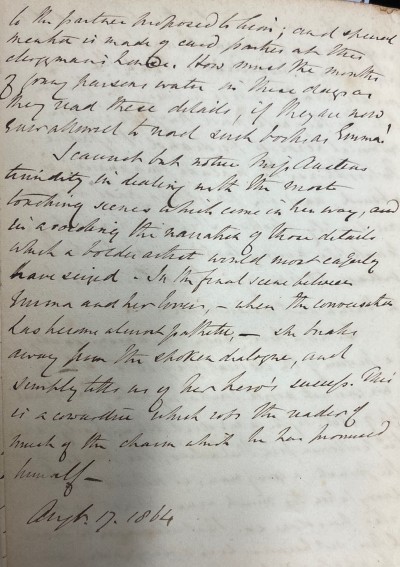 Leaf 3. © Princeton University Library. All rights reserved. |
Leaf 430
| The only person tipsey the clergyman ———— 114 The clergymans wife & her card parties p 258.277 The clergyman dances PO delivery —— 263 – Manner of dancing – 290 and yet they had spoken of ‘waltzes’ – |
 Leaf 4. © Princeton University Library. All rights reserved. |
ACKNOWLEDGEMENTS
I would like to thank Dr. John Avery Jones for kindly reading and commenting on a draft of this essay, Michael G. Williamson of the Trollope Society for his helpful responses to my enquiries, and Mick Bright and Jo Strong for their assistance at Senate House. I would also like to acknowledge the assistance provided by the archivists of Camden Local Studies and Archives Centre, Harrow School and the Harrow Local History Collection, and Emma Sarconi of Princeton University Library for kindly providing the images of Trollope’s note on Emma.
N O T E S
1John Hall gives the date for Barbara Meetkerke’s death as 28 July (12) and R. H. Super gives 22 July (5), but the memorial inscription appears to say 25 July (https://www.findagrave.com/memorial/215011959/barabara-meetkerke). Both Hall (558) and Victoria Glendinning in Trollope (xiv) state in their family trees that Adolphus Meetkerke died in 1840, but 1841 is confirmed by his memorial inscription (https://www.findagrave.com/memorial/200238644/adolphus-meetkerke) and the official register of deaths available via Ancestry.co.uk.
2The time period would have predated Richard Bentley’s single volume editions of 1832–1833, but, curiously, Trollope leaves this detail unexplained.
3The census of 1841 estimates her to have been born about 1790.
4According to Heineman, the lease on Keppel Street was his from at least 1806 (262n14).
5The question of when the Trollope family moved from London to Harrow is an important one, but there is no consensus. Super states, “They moved sometime between May 18, 1815, when Anthony was baptized in London, and February 19, 1817, when William Milton came over to baptize Cecilia in the Harrow parish church; probably the move was close to the former date” (4). Hall agrees, stating that the move was after Trollope’s birth and that Cecilia was born in Harrow (11). Michael Sadleir states in Trollope: A Commentary that Thomas Anthony decided to leave London early in 1816 (42) but that “his wife and children were established in the new home in 1817” (44). Thomas Trollope recalled, “I was, I think, about eight years old when my parents removed from Keppel Street to Harrow-on-the-Hill” (57), which would be around 1818. Since What I Remember was published in 1887, his memory may not have been entirely reliable; indeed, Heineman states that Thomas was unsure of the date and himself sought clarification (264n5). John Sutherland states, without providing a source, that the move came in the year of Trollope’s birth (642); Super (438n13) quotes Heineman, who cites the Poor Rate Books for St. George’s parish, Bloomsbury, as evidence that the date of the move was before the end of 1815, stating that No. 16 was empty in 1815 and another occupant appears in it from 1816 to 1819 (264n5).
I have examined a microfilm version of the relevant books (UTAH 118 at Camden Local Studies and Archives Centre, Holborn Library), but my findings were inconclusive. Super also mentions in the same note correspondence in the Vaughan Library at Harrow School between Trollope’s father and Lord Northwick regarding pew rent, which would help establish the date of the move. I have been informed by the school’s archivist, however, that they unfortunately do not hold this correspondence. Confirmation from a former archivist at Harrow School that certain items perhaps seen by Heineman have been subsequently lost can be found in Neville-Sington’s Fanny Trollope: The Life and Adventures of a Clever Woman (376n10).
6The works are Father Giles of Ballymoy, Lady Anna, and Orley Farm. See also Mullen and Munson, who note that Charles Stewart Parnell took lodgings at No.16 in 1875 and may have been visited there by his mistress Mrs. O’Shea (259–60).
7Augustus Pugin was born on 1 March 1812 at No. 39 Keppel Street, and later Dickens installed his father at No. 34, where he died in 1851 with Dickens by his side (Tomalin xx).
8Charles Austen subsequently married Harriet in 1820.
9Scott had previously been included as a poet.
10Trollope had actually written “Lady Charlotte De Burgh” and continued “With the Mansfields and Crofts” which was corrected to “With the Bertrams and the Crawfords.”
11Mullen and Munson state that he wrote his autobiography between October 1875 and April 1876, although he subsequently made changes (20).
12But see Neville-Sington’s “Jane Austen and the Trollopes” and Horwitz’s “Pride and Prejudice and Framley Parsonage: A Structural Resemblance.”
13The fact that Thomas Fowle (1765–1797), fiancé of Cassandra Austen (1773–1845), held a living at Allington, Wiltshire, and that Trollope used the place name in one of his best-known novels seems to be complete coincidence. Trollope did use real place names, and there are several Allingtons in England, but it seems likely he was thinking of the one located in Dorset, near Whitchurch Canonicorum, the inspiration for the Crabtree Canonicorum of Barset. I am very grateful to Michael G. Williamson for drawing my attention to this idea.
14Looser corrects Southam’s identification of “Miss P. K. M. Sweeting” (Southam 96).
15Classmark 19th-675RHT–19th-679RHT
20“Knightley” (Booth, Shrimpton)
21“selfish” omitted (Booth, Shrimpton)
22“Bath-begotten” (Booth, Shrimpton)
23“self-denying” (Booth, Shrimpton)
26“Knightleys” (Booth, Shrimpton)
27“fast-living” (Booth, Shrimpton)
29exclamation mark omitted in Booth, Shrimpton
30Leaf 4 is unmentioned by either Booth or Shrimpton. It appears to be made up of observations in Trollope’s hand that contribute towards the note. The numbers quoted refer to pages, as can be verified in the 1833 edition of Emma available online: https://books.google.co.uk/books?id=Y8UNAAAAQAAJ.
